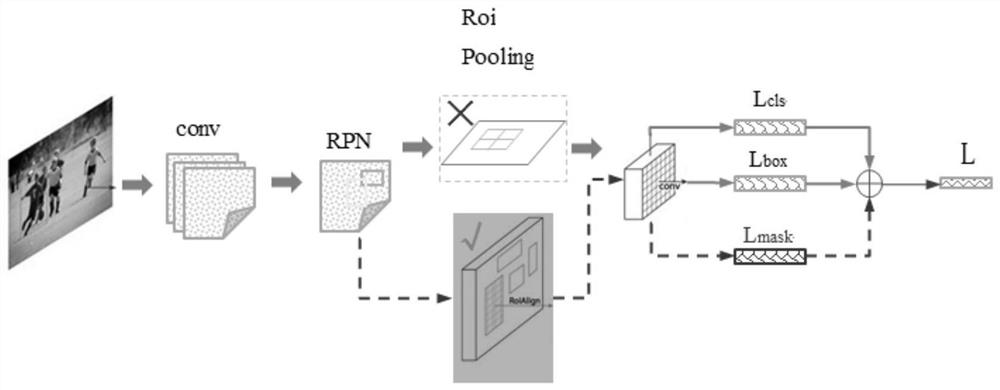Tunnel crack identification method based on deep learning and OpenCV
A deep learning and crack recognition technology, applied in the field of deep learning and graphics processing, can solve the problems of high accuracy of labeling data, difficulty in labeling, and few samples.
- Summary
- Abstract
- Description
- Claims
- Application Information
AI Technical Summary
Problems solved by technology
Method used
Image
Examples
Embodiment 1
[0073] A tunnel crack recognition method based on deep learning and OpenCV, including:
[0074] Step 1: Use deep learning technology to find out the general location and shape of the crack: based on Mask-RCNN, figure 1 It is a schematic diagram of the Mask-RCNN network structure. Using the labeled tunnel crack picture data set to train a model that can identify the general position and shape of the crack, a mask of a crack picture is given, such as figure 2 As shown, the next step is to extract cracks within the mask range;
[0075] Step 2: Use image processing technology to refine the identified cracks: first, perform corrosion operations on the mask to make it contain more comprehensive crack information, such as image 3 As shown, the skeleton is extracted in the corroded mask area; then the extracted crack skeleton is combined with the original image, and the crack is filled by the neighborhood region growing algorithm;
[0076] Step 3: Statistics of crack length and w...
Embodiment 2
[0078] A method for identifying tunnel cracks based on deep learning and OpenCV, as shown in Embodiment 1, the difference is that step 1 specifically includes the following steps:
[0079] 1.1. Input the entire image into the network;
[0080] 1.2. Input the image into CNN for feature extraction. In this layer, the masks obtained by different scales are finally superimposed as the mask of the original image;
[0081] 1.3. Use FPN to generate proposal windows (proposals), and generate N proposal windows for each picture;
[0082] 1.4. Map multiple suggestion windows generated by FPN to the last layer of convolution feature map of CNN;
[0083] 1.5. Through the RoI Align layer, each RoI generates a fixed-size feature map;
[0084] 1.6. Finally, use full connection classification, border, and mask for regression.
[0085] exist figure 1 Among them, conv is a convolutional layer for feature extraction; RPN is a region generation network for extracting candidate boxes; L is a ...
Embodiment 3
[0088] A tunnel crack recognition method based on deep learning and OpenCV, as shown in Embodiment 1, the difference is that the skeleton extraction process in step 2 is:
[0089] 2.1. Image grayscale: use the weighted average method to weight the values of R, G, and B according to the weights of R: 0.299, G: 0.587, and B: 0.114;
[0090] 2.2. Contrast enhancement:
[0091] The characteristic parameters of the picture include the overall gray value and the overall gray value variance. The histogram is divided into two parts by using the OTSU algorithm. The gray value of the former part is small, and the gray value of the latter part is large. , which may be the gray value of the crack, with few features and small gray value, and the latter part is defined as the background gray value, which may be the gray value of the background, with many features and large gray value, calculate the gray value of these two parts respectively The mean value of the gray level, the differenc...
PUM
 Login to View More
Login to View More Abstract
Description
Claims
Application Information
 Login to View More
Login to View More - R&D
- Intellectual Property
- Life Sciences
- Materials
- Tech Scout
- Unparalleled Data Quality
- Higher Quality Content
- 60% Fewer Hallucinations
Browse by: Latest US Patents, China's latest patents, Technical Efficacy Thesaurus, Application Domain, Technology Topic, Popular Technical Reports.
© 2025 PatSnap. All rights reserved.Legal|Privacy policy|Modern Slavery Act Transparency Statement|Sitemap|About US| Contact US: help@patsnap.com



